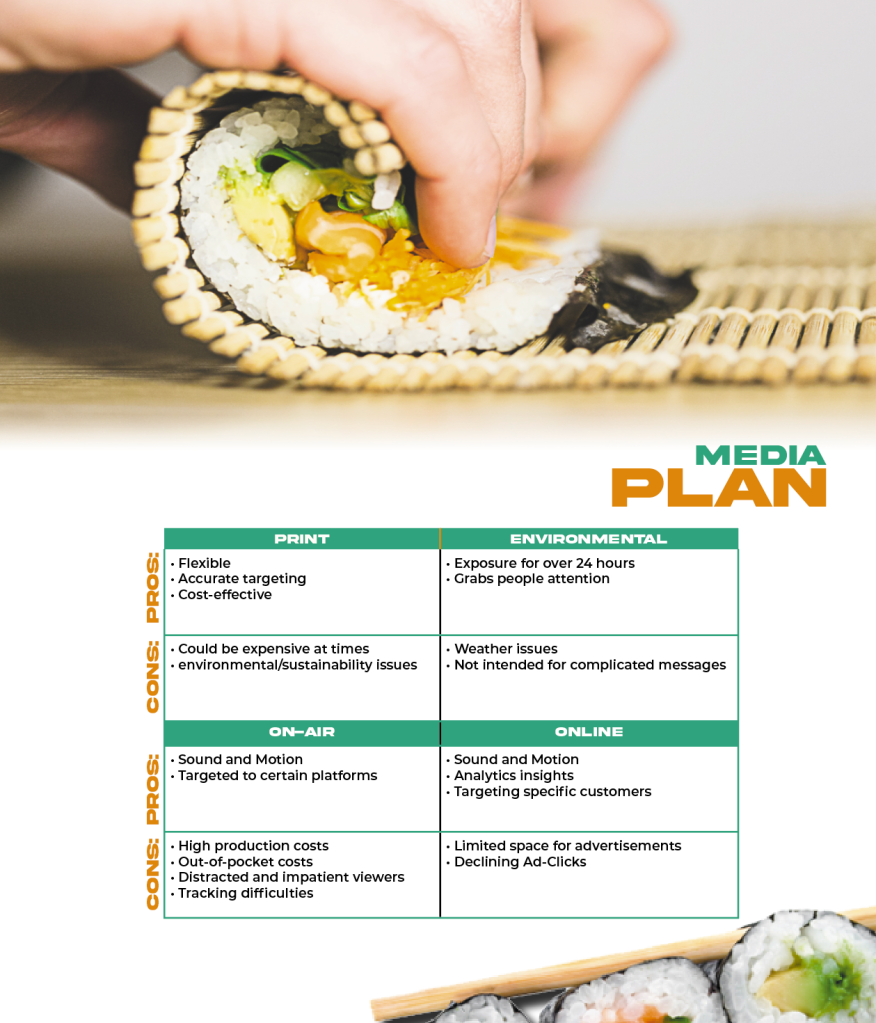Overview of the material and concepts learned this month.
Connecting/Synthesizing/Transforming
In this month’s course, the class continued to work on the BoxPark Sushi brand. During the month, we were introduced to identifying the brand tone and voice for the brand and a dynamic and static vision board–which was designed in order to show the brands voice and tone would be expressed through dynamic and static media.
Furthermore, a media plan was developed to determine some of the negatives and positives of each piece of media I will design later in my journey and a design brief, figuring out the objectives of the project; figuring out what the client wants from the design and try to get them to be as specific as possible (Frenson, 2016).
Secondary research was conducted in regards to brand voice and tone, dynamic media and communicating through design in order to understand the look and feel of the brand overall, making sure everything is consistent. For the brand’s voice and tone, most of my research came from the article title How to Define your Unique Brand Voice and Stand Out. In this article, CoSchedule mentioned “that your voice describes your company’s personality–it is consistent and unchanging” (CoSchedule, 2016). The tone is the emotional inflection applied to your voice. Although the voice of the brand stays consistent, your tone may change depending on the context of your message.
Communicating the message through design is very important as a graphic designer. in Adam Toda’s article Design is Communication , he mentioned that “Good Design doesn’t happen by chance. Good design happened from executed purpose and intent” (Toda, 2017). Toda also mentioned that to communicate the message effectively, you have to choose the right visual elements. The dynamic vision board below effectively communicates my brand of BoxPark Sushi, emphasizing to come to BoxPark Sushi if you are willing to taking a risk and and try something new and out of your comfort zone.
Problem Solving
A design problem that needed to be solved this month was to figure out how to effectively communicate the brand through the dynamic and static vision board.
Onliness Statement: BoxPark Sushi is the only traditional sushi restaurant that will serve innovative and quality Caribbean style sushi at an affordable price for marginalized communities in East Side Milwaukee who needs better representation in their food choices.
my characteristics for the brand are exotic, adventurous and authentic. I chose those three characteristics because they embody how a typical trip to the Caribbean is. People want to travel more, take risks, and eat really good food. But how in the world I am going to put that on a vision board? Since my target audience are younger and older professionals, colleges students, etc. I wanted to go for a fun and exciting approach. I always look for inspiration online and that was how I got my juices flowing while doing the project. I wanted to incorporate the beach and certain images that represents the overall look of the brand. In my critique I mentioned that sushi wasn’t included in the static vision board, but I had to make sure sushi was included in the static vision board so the target audience know this BoxPark SUSHI, not BoxPark Caribbean.

Innovative thinking
I think what was very innovative this month was the Media Matrix. A Media Matrix explains the pros and cons of each piece of delivery I design next class. This matrix was the first thing I had to complete before selecting 5 to 7 media assets and finalizing the design brief. Although the media matrix template was useful to determine the media assets, I will utilize the media matrix in future projects whether I am at work or freelancing. This will set me apart from the rest of the other design professionals and make the design process more organized than stagnant.

Acquiring Competencies
- Visual Hierarchy: Arranging elements to show their order of importance (academic, conceptual)
- Parallax Effect: background element scrolls slower than the foreground content, so it will add depth to the background image, which makes the image interactive. (Occupational, technical).
- Vision Board: A collage of images and words representing a person’s wishes or goals, intended to serve as inspiration or motivation. (Occupational, technical)
- Dynamic Vision Board: Same as vision board, but using motion and sound.
- Voice: Describes the company’s personality. (conceptual, occupational)
- Tone: The emotional inflection applied to your voice. Can change depending on the context of your brand. (conceptual, occupational)
- Tagline: Single sentence description of the brand. Keeps the target audience familiar with the brand. (Conceptual, occupational)
- Design Brief: According to Frenson, includes the objective and strategies defined in the creative brief, but also adds additional information (Frenson, 2015). Color Palettes, voice and tone and media strategies are included. (Occupational, conceptual)
- Media Martix: A plan that explains the pros and cons of each piece of delivery media I will design. (Occupational, conceptual)
References:
CoSchedule. (2020, November 16). How to define your unique brand voice and stand out. CoSchedule Blog. https://coschedule.com/marketing-strategy/brand-voice#brandvoice
Frenson, M. (2016, July 5). How to write effective design briefs: a quick guide. https://unmatchedstyle.com/news/how-to-write-effective-design-briefs-a-quick-guide.php
Toda, A. (2017, February 7). Design is communication. Medium. https://medium.theuxblog.com/design-is-communication-e371ad9042a3